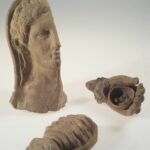Inspired by the international colloquium Exvoto: Creation, Subversion, and Transgression, I wanted to explore the spiritual and subversive potential of materializing a desire and, beyond that, seeking a transgressive meaning to integrate into an artistic ritual. Let’s explore why offerings can be used as creative techniques for the transgression of beliefs.
Why make offerings? What are ex-votos?
First, it would be useful to define what these devotional expressions consist of. From worship and devotion to a higher power, the devotee seeks acceptance and recognition while hoping to have their prayers answered in the best possible way.

With this purpose, their hopes are materialized through symbolic objects, sometimes as diverse and surprising as food, body parts, virtual letters, or living beings.
This concept of transaction with an invisible world has existed from the Neolithic period in Syria to other more contemporary places of worship, such as Buddhist temples in Japan or threads of messages on social networks. Humans have never stopped expressing their emotions and feelings through objects.
A supportive tool for the human psyche

Similar to D. Winnicott‘s transitional object (Playing and Reality, 1982), the ex-voto functions as a modeling agent in the area of illusion, allowing the development of an attachment to a higher power in the absence of its physical presence, thus facilitating psychic processes that enable the assimilation or transformation of a message. The ultimate goal of the devotee is to fulfill their wish.
In this aspect, art therapy seeks to reuse this symbology to understand or transform faith or the immaterial sensitivity as Yves Klein referred to it.
Not only is it an interactional triangle between the human, their vow, and the representation of that powerful entity.
The sacredness of desire
Being linked to an external entity, usually endowed with divine powers, the object is considered with respect and allows for a greater focus, as it opens the way to a mysterious and intangible plan that only the devotee is allowed to access.
A temporal factor

Although the object may be ephemeral, ornamental, intended to remain or be destroyed, it seems that when it is made, the very process of its creation by the devotee enters into the ritualization of the associated favor. This grants the object a temporal quality that can be highly significant in the intention and the transformation process linked to the vow. For example, it may involve lighting it on fire or hanging it with other similar objects to make it visible to the community.
Visibility

As described by José Cláudio Alves de Oliveira and Caroline Perrée in their project “Núcleo de Pesquisa dos Ex-votos“ it is not only an interactional triangle between the human, their vow, and the representation of that powerful entity, but it also involves a spatial, formal communicational, and informative component with the spectator, validating the message collectively. In sites where miracles are expected and, for example, hundreds of these objects can be observed, their repetition transcends the simple individual vow; rather, the abundance of their material turns it into a social act. The materialization itself becomes an exhibition, and accumulation turns it into a mass will.
The power of invisible dialogue
Beyond sometimes becoming an inventory that becomes knowledge (artistic, ethnological, historical), the vow finds its strength in its intangibility. It is attributed the essence of an ideal dialogue where both parties understand each other as if they were one.
In what way can these offerings be tools for the transgression of beliefs?
The word “transgression” comes from the Latin “transgressio” and means “the action and effect of harming someone” (Etimológico Dictionary, 2019).
According to the same dictionary, the verb “transgress” refers to “not respecting, bypassing, going beyond norms or customs.” On the other hand, considering Peirce’s reasoning (1890), we see that beliefs are a way to fight against forms of uncertainty that disadvantage the community. It is, therefore, for beneficial and social logic purposes that we define the roots of our reasoning (what he would call the “agapastic” or “socialist” ontology).
Why, then, would an individual have the goal of transgressing what has been established as rational and beneficial for the community to which they belong?
It is at this precise moment of rupture when disruptive invocations appear, sometimes against the divine doctrine itself, with desires that modify paradigms at a societal or individual level.
Between the impossible and the individual, the future concretization of an intention interposes.
From creation: Metamorphosis and transmutation, transgression opens the path of transcendence

Whether it is part of a need for a change in the model of reality, a spiritual quest, resolving a personal conflict, healing, or responding to a contradiction, the use of the vow becomes a tool to communicate with the real world, external from the most sensory and subtle to the invisible and sacred. It interposes between the impossible and the rational as the future concretization of an intention. One transforms into what could be, ritualizes it, and validates it before others. This mysterious desire, this dream, was never real until it was expressed: the irrationality, poetry, and symbolism of a thought simply come into existence.
Bibliography
- Gloria Fraser Giffords Artes de México, No. 53, EXVOTOS (2000), pp. 8-23
- José Cláudio Alves de Oliveira and Caroline Perrée, “Spatialités et objets votifs,” Techniques & Culture [Online], 70 | 2018, Online since 06 December 2020,
- Jesús Binetti, “Cuando la fe sana: Los recursos religiosos tradicionales en la enfermedad y la epidemia,” pp. 83-114
- Cover Photo: “Wishes written in seashells at a Buddhist temple” by Vitalina
To participate in our artistic and therapeutic experiences, we advise you to check out our upcoming events❤️




